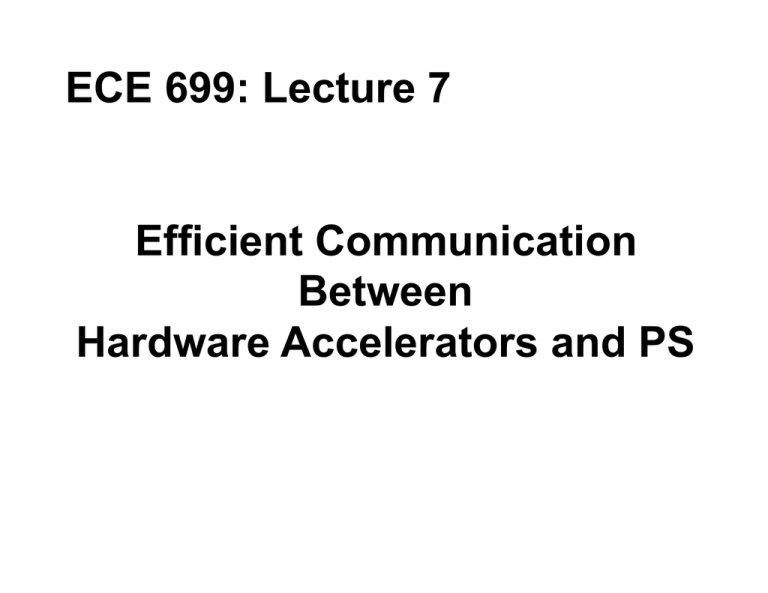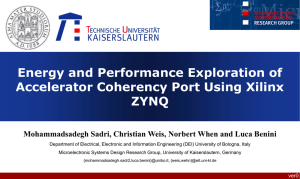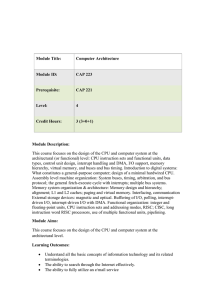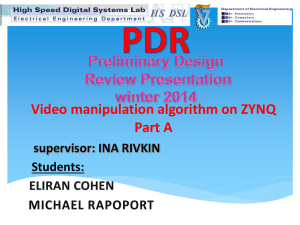Efficient Communication Between Hardware Accelerators and PS
advertisement

ECE 699: Lecture 7
Efficient Communication
Between
Hardware Accelerators and PS
Recommended Videos & Slides
M.S. Sadri, ZYNQ Training
• Lesson 12 – AXI Memory Mapped Interfaces
and Hardware Debugging
• Lesson 7 – AXI Stream Interface In Detail (RTL Flow)
• Lesson 9 – Software development for ZYNQ using
Xilinx SDK (Transfer data from ZYNQ PL to PS)
Xilinx Advanced Embedded System Design on Zynq
• Memory Interfacing (see Resources on Piazza)
Recommended Paper & Slides
M. Sadri, C. Weis, N. Wehn, and L. Benini,
“Energy and Performance Exploration of
Accelerator Coherency Port Using Xilinx ZYNQ,”
Proc. 10th FPGAworld Conference, Stockholm 2013,
available at
http://www.googoolia.com/wp/2014/03/07/my-cv/
Mapping of an Embedded SoC
Hardware Architecture to Zynq
Source: Xilinx White Paper: Extensible Processing Platform
Simple Custom Peripheral
Source: M.S. Sadri, Zynq Training
Simple Custom Accelerator
Source: M.S. Sadri, Zynq Training
Example of a Custom Accelerator
Source: M.S. Sadri, Zynq Training
Block Diagram of the Pattern Counter
Source: M.S. Sadri, Zynq Training
Ways of Implementing AXI4 Slave Units
Source: M.S. Sadri, Zynq Training
Pixel Processing Engine
Source: M.S. Sadri, Zynq Training
PS-PL Interfaces and Interconnects
Source: The Zynq Book
General-Purpose Port Summary
• GP ports are designed for maximum flexibility
• Allow register access from PS to PL or PL to PS
• Good for Synchronization
• Prefer ACP or HP port for data transport
High-Performance Port Summary
•
HP ports are designed for maximum bandwidth
access to external memory and OCM
•
When combined can saturate external memory
and OCM bandwidth
– HP Ports : 4 * 64 bits * 150 MHz * 2 = 9.6 GByte/sec
– external DDR: 1 * 32 bits * 1066 MHz * 2 = 4.3 GByte/sec
– OCM : 64 bits * 222 MHz * 2 = 3.5 GByte/sec
•
Optimized for large burst lengths and many
outstanding transactions
•
Large data buffers to amortize access latency
•
Efficient upsizing/downsizing for 32 bit accesses
Using Central DMA
Source: M.S. Sadri, Zynq Training
Central DMA
• High-bandwidth Direct
Memory Access (DMA)
between a memorymapped source address
and a memory-mapped
destination address
• Optional Scatter Gather
(SG)
• Initialization, status, and
control registers are
accessed through an
AXI4-Lite slave interface
Source: Xilinx Advanced Embedded System Design on Zynq
Using Central DMA in the Scatter-Gather Mode
Source: M.S. Sadri, Zynq Training
Scatter Gather DMA Mode
Source: Symbian OS Internals/13. Peripheral Support
Custom Accelerator with the Master
AXI4 Interface
Source: M.S. Sadri, Zynq Training
Ways of Implementing AXI4 Master Units
Source: M.S. Sadri, Zynq Training
AXI4-Full
Source: M.S. Sadri, Zynq Training
Image Rotation Unit
Source: M.S. Sadri, Zynq Training
FFT Unit
Source: M.S. Sadri, Zynq Training
Sample Generator
Source: M.S. Sadri, Zynq Training
PL-PS Interfaces
Source: M.S. Sadri, Zynq Training
Accelerator Architecture with DMA
Source: Building Zynq Accelerators with Vivado HLS, FPL 2013 Tutorial
AXI DMA-based Accelerator Communication
Write to Accelerator
• processor allocates buffer
• processor writes data into buffer
• processor flushes cache for buffer
• processor initiates DMA transfer
Read from Accelerator
• processor allocates buffer
• processor initiates DMA transfer
• processor waits for DMA to complete
• processor invalidates cache for buffer
• processor reads data from buffer
Flushing and Invalidating Cache
/* Flush the SrcBuffer before the DMA transfer */
Xil_DCacheFlushRange((u32)TxBufferPtr, BYTES_TO_SEND);
........
/* Invalidate the DstBuffer after the DMA transfer */
Xil_DCacheInvalidateRange((u32)RxBufferPtr, BYTES_TO_RCV);
Simple DMA Transfer
Programming Sequence for MM2S channel (1)
1. Start the MM2S channel running by setting the run/stop bit
to 1, MM2S_DMACR.RS = 1.
2. If desired, enable interrupts by writing a 1 to
MM2S_DMACR.IOC_IrqEn and MM2S_DMACR.Err_IrqEn.
3. Write a valid source address to the MM2S_SA register.
4. Write the number of bytes to transfer in
the MM2S_LENGTH register.
The MM2S_LENGTH register must be written last.
All other MM2S registers can be written in any order.
Simple DMA Transfer
Programming Sequence for S2MM channel (1)
1. Start the S2MM channel running by setting the run/stop bit
to 1, S2MM_DMACR.RS = 1.
2. If desired, enable interrupts by by writing a 1 to
S2MM_DMACR.IOC_IrqEn and S2MM_DMACR.Err_IrqEn.
3. Write a valid destination address to the S2MM_DA register.
4. Write the length in bytes of the receive buffer in the
S2MM_LENGTH register.
The S2MM_LENGTH register must be written last.
All other S2MM registers can be written in any order.
Transmitting and Receiving a Packet
Using High-Level Functions
/* Transmit a packet */
Status = XAxiDma_SimpleTransfer(&AxiDma,(u32) TxBufferPtr,
BYTES_TO_SEND, XAXIDMA_DMA_TO_DEVICE);
if (Status != XST_SUCCESS) { return XST_FAILURE; }
while (!TxDone);
......
/* Receive a packet */
Status = XAxiDma_SimpleTransfer(&AxiDma,(u32) RxBufferPtr,
BYTES_TO_RCV, XAXIDMA_DEVICE_TO_DMA);
if (Status != XST_SUCCESS) { return XST_FAILURE; }
while (!RxDone);
Transmitting a Packet
Using Lower-Level Functions
/* Transmit a packet */
Xil_Out32(AxiDma.TxBdRing.ChanBase +
XAXIDMA_SRCADDR_OFFSET, (u32) TxBufferPtr);
Xil_Out32(AxiDma.TxBdRing.ChanBase + XAXIDMA_CR_OFFSET,
Xil_In32(AxiDma.TxBdRing.ChanBase +XAXIDMA_CR_OFFSET)
| XAXIDMA_CR_RUNSTOP_MASK);
Xil_Out32(AxiDma.TxBdRing.ChanBase +
XAXIDMA_BUFFLEN_OFFSET, BYTES_TO_SEND);
while (TxDone == 0);
Receiving a Packet
Using Lower-Level Functions
/* Receive a packet */
Xil_Out32(AxiDma.RxBdRing.ChanBase +
XAXIDMA_DESTADDR_OFFSET, (u32) RxBufferPtr);
Xil_Out32(AxiDma.RxBdRing.ChanBase+XAXIDMA_CR_OFFSET,
Xil_In32(AxiDma.RxBdRing.ChanBase+XAXIDMA_CR_OFFSET)
| XAXIDMA_CR_RUNSTOP_MASK);
Xil_Out32(AxiDma.RxBdRing.ChanBase +
XAXIDMA_BUFFLEN_OFFSET, BYTES_TO_RCV);
while (RxDone == 0);
PL-PS Interfaces
Source: M.S. Sadri, Zynq Training
Accelerator Architecture with Coherent DMA
Source: Building Zynq Accelerators with Vivado HLS, FPL 2013 Tutorial
Coherent AXI DMA-based Accelerator
Communication
Write to Accelerator
• processor allocates buffer
• processor writes data into buffer
• processor flushes cache for buffer
• processor initiates DMA transfer
Read from Accelerator
• processor allocates buffer
• processor initiates DMA transfer
• processor waits for DMA to complete
• processor invalidates cache for buffer
• processor reads data from buffer
Accelerator Coherency Port (ACP) Summary
•
ACP allows limited support for Hardware Coherency
– Allows a PL accelerator to access cache of the Cortex-A9 processors
– PL has access through the same path as CPUs including caches,
OCM, DDR, and peripherals
– Access is low latency (assuming data is in processor cache)
no switches in path
•
ACP does not allow full coherency
– PL is not notified of changes in processor caches
– Use write to PL register for synchronization
•
ACP is compromise between bandwidth and latency
– Optimized for cache line length transfers
– Low latency for L1/L2 hits
– Minimal buffering to hide external memory latency
– One shared 64 bit interface, limit of 8 masters
AXI-based DMA Services
• Four AXI-based DMA services are provided
– Central DMA (CDMA)
• Memory-to-memory operations
– DMA
• Memory to/from AXI stream peripherals
– FIFO Memory Mapped To Streaming
• Streaming AXI interface alternative to traditional DMA
– Video DMA
• Optimized for streaming video application to/from memory
Source: Xilinx Advanced Embedded System Design on Zynq
Streaming FIFO
Source: Xilinx Advanced Embedded System Design on Zynq
Streaming FIFO
• General AXI interconnect has no
support for the AXI stream interface
– axi_fifo_mm_s provides this
facility
– FIFO included
• Added as all other types of IP are
from the IP Catalog
• Features
– AXI4/AXI4-Lite slave interface
– Independent internal 512B-128KB
TX and RX data FIFOs
– Full duplex operation
Source: Xilinx Advanced Embedded System Design on Zynq
Streaming FIFO
• Slave AXI connection
– RX/TX FIFOs
– Interrupt controller
– Control registers
• Three user-side AXI Stream
interfaces
– TX data
– RX data
– TX control
AXI Video DMA Controller
Source: Xilinx Advanced Embedded System Design on Zynq
Design Goal
Hardware accelerator capable of working for
arbitrary values of parameters
lm, ln, lp,
defined in software, with the only limitations imposed
by the total size and the word size of internal
memories.
Passing Parameters to an Accelerator
Option 1: Parameters (e.g., lm, ln, lp) are passed
using AXI_Lite
Option 2: Parameters (e.g., lm, ln, lp) are passed
in the header of input data
Option 3: Parameters inferred from the size of
transmitted input data (not possible in
general case of matrix multiplication)
Input size:
Output size:
(2lm+ln + 2lp+lm)*8
(2lp+ln)*32 (for lm≤16)
Choosing Optimal Parameters
Source: M.S. Sadri, Zynq Training
Energy and Performance
Exploration of Accelerator
Coherency Port Using Xilinx ZYNQ
Mohammadsadegh Sadri, Christian Weis, Norbert When and
Luca Benini
Department of Electrical, Electronic and Information Engineering (DEI) University of Bologna, Italy
Microelectronic Systems Design Research Group, University of Kaiserslautern, Germany
{mohammadsadegh.sadr2,luca.benini}@unibo.it, {weis,wehn}@eit.uni-kl.de
ver0
Processing Task Definition
We define : Different methods to
accomplish the task.
Measure : Execution time & Energy.
Image Sizes:
4KBytes
16K
65K
128K
256K
1MBytes
2MBytes
Source Image
(image_size
bytes)
Result Image
Selection of Pakcets:
(image_size
(Addressing)
bytes)
- Normal
- Bit-reversed
@Source
@Dest
Address
Address
Loop: N times
Measure execution interval.
128K
Allocated by:
kmalloc
dma_alloc_coherent
Depends on the memory
Sharing method
FIFO: 128K
read
FIR
write
process
Mohammadsadegh Sadri, Christian Weis, Norbert Wehn, Luca Benini – Energy and performance
exploration of ACP Using ZYNQ
46
Memory Sharing Methods
• ACP Only (HP only is similar, there is no SCU and L2)
Accelerat
or
ACP
SC
U
L2
DRAM
• CPU only (with&without cache)
• CPU ACP
(CPU HP similar)
CPU
2
1
Accelerat
or
ACP
SC
U
L2
DRAM
ACP ---CPU ---ACP --Mohammadsadegh Sadri, Christian Weis, Norbert Wehn, Luca Benini – Energy and performance
exploration of ACP Using ZYNQ
47
Speed Comparison
ACP Loses!
CPU OCM between
CPU ACP & CPU HP
298MBytes/s
239MBytes/s
4K
16K
64K 128K
256K
1MBytes
Mohammadsadegh Sadri, Christian Weis, Norbert Wehn, Luca Benini – Energy and performance
exploration of ACP Using ZYNQ
48
Energy Comparison
CPU only methods : worst case!
CPU OCM always between
CPU ACP and CPU HP
CPU ACP ; always better energy than CPU HP0
When the image size grows CPU ACP converges CPU HP0
Mohammadsadegh Sadri, Christian Weis, Norbert Wehn, Luca Benini – Energy and performance
exploration of ACP Using ZYNQ
49
Lessons Learned & Conclusion
• If a specific task should be done by accelerator only:
• For small arrays ACP Only & OCM Only can be used
• For large arrays (>size of L2$) HP Only always acts
better.
• If a specific task should be done by the
cooperation of CPU and accelerator:
• CPU ACP and CPU OCM are always
better than CPU HP in terms of energy
• If we are running other applications which
heavily depend on caches, CPU OCM and then
CPU HP are preferred!
Mohammadsadegh Sadri, Christian Weis, Norbert Wehn, Luca Benini – Energy and performance
exploration of ACP Using ZYNQ
50





